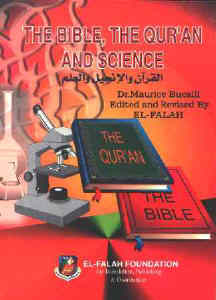Bible,Quran and Science

The Old Testament
General Outlines
Who is the author of the Old Testament?
One wonders how many readers of the Old Testament, if asked the above question, would reply by repeating what they had read in the introduction to their Bible. They might answer that, even though it was written by men inspired by the Holy Ghost, the author was God.
Sometimes, the author of the Bible's presentation confines himself to informing his reader of this succinct observation which puts an end to all further questions. Sometimes he corrects it by warning him that details may subsequently have been added to the primitive text by men, but that nonetheless, the litigious character of a passage does not alter the general "truth' that proceeds from it. This "truth' is stressed very heavily. The Church Authorities answer for it, being the only body, With the assistance of the Holy Ghost, able to enlighten the faithful on such points. Since the Councils held in the Fourth century, it was the Church that issued the list of Holy Books, ratified by the Councils of Florence (1441), Trent (1546), and the First Vatican Council (1870), to form what today is known as the Canon. Just recently, after so many encyclicals, the Second Vatican Council published a text concerning the Revelation which is extremely important. It took three years (1962-1966) of strenuous effort to produce. The vast majority of the Bible's readers who find this highly reassuring information at the head of a modern edition have been quite satisfied with the guarantees of authenticity made over past centuries and have hardly thought it possible to debate them.
When one refers however to works written by clergymen, not meant for mass publication, one realizes that the question concerning the authenticity of the books in the Bible is much more complex than one might suppose a priori. For example, when one consults the modern publication in separate installments of the Bible in French translated under the guidance of the Biblical School of Jerusalem [ Pub. Cerf, Paris], the tone appears to be very different. One realizes that the Old Testament, like the New Testament, raises problems with controversial elements that, for the most part, the authors of commentaries have not concealed.
We also find highly precise data in more condensed studies of a very objective nature, such as Professor Edmond Jacob's study. The Old Testament (L'Ancien Testament) [ Pub. Presses Universitaires de France, Paris "Que sais-je?" collection]. This book gives an excellent general view.
Many people are unaware, and Edmond Jacob points this out, that there were originally a number of texts and not just one. Around the Third century B.C., there were at least three forms of the Hebrew text: the text which was to become the Masoretic text, the text which was used, in part at least, for the Greek translation, and the Samaritan Pentateuch. In the First century B.C., there was a tendency towards the establishment of a single text, but it was not until a century after Christ that the Biblical text was definitely established.
If we had had the three forms of the text, comparison would have been possible, and we could have reached an opinion concerning what the original might have been. Unfortunately, we do not have the slightest idea. Apart from the Dead Sea Scrolls (Cave of Qumran) dating from a pre-Christian era near the time of Jesus, a papyrus of the Ten Commandments of the Second century A.D. presenting variations from the classical text, and a few fragments from the Fifth century A.D. (Geniza of Cairo) , the oldest Hebrew text of the Bible dates from the Ninth century A.D.
The Septuagint was probably the first translation in Greek. It dates from the Third century B.C. and was written by Jews in Alexandria. It Was on this text that the New Testament was based. It remained authoritative until the Seventh century A.D. The basic Greek texts in general use in the Christian world are from the manuscripts catalogued under the title Codex Vaticanus in the Vatican City and Codex Sinaiticus at the British Museum, London. They date from the Fourth century A.D.
At the beginning of the Fifth century A.D., Saint Jerome was able to produce a text in latin using Hebrew documents. It was later to be called the Vulgate on account of its universal distribution after the Seventh century A.D.
For the record, we shall mention the Aramaic version and the Syriac (Peshitta) version, but these are incomplete.
All of these versions have enabled specialists to piece together so-called 'middle-of-the-road' texts, a sort of compromise between the different versions. Multi-lingual collections have also been produced which juxtapose the Hebrew, Greek, Latin, Syriac, Aramaic and even Arabic versions. This is the case of the famous Walton Bible (London, 1667). For the sake of completeness, let us mention that diverging Biblical conceptions are responsible for the fact that the various Christian churches do not all accept exactly the same books and have not until now had identical ideas on translation into the same language. The Ecumenical Translation of the Old Testament is a work of unification written by numerous Catholic and Protestant experts now nearing completion [ Translator's Note: Published December 1975 by Les Editions du Cerf and Les Bergers et les Mages, Paris] and should result in a work of synthesis.
Thus the human element in the Old Testament is seen to be quite considerable. It is not difficult to understand why from version to version, and translation to translation, with all the corrections inevitably resulting, it was possible for the original text to have been transformed during the course of more than two thousand years.ORIGINS OF THE BIBLE
Before it became a collection of books, it was a folk tradition that relied entirely upon human memory, originally the only means of passing on ideas. This tradition was sung.
"At an elementary stage, writes E. Jacob, every people sings; in Israel, as elsewhere, poetry preceded prose. Israel sang long and well; led by circumstances of his history to the heights of joy and the depths of despair, taking part with intense feeling in all that happened to it, for everything in their eyes had a sense, Israel gave its song a wide variety of expression". They sang for the most diverse reasons and E. Jacob mentions a number of them to which we find the accompanying songs in the Bible: eating songs, harvest songs, songs connected with work, like the famous Well Song (Numbers 21, 17), wedding songs, as in the Song of Songs, and mourning songs. In the Bible there are numerous songs of war and among these we find the Song of Deborah (Judges 5, 1-32) exalting Israel's victory desired and led by Yahweh Himself, (Numbers 10, 35); "And whenever the ark (of alliance) set out, Moses said, 'Arise, oh Yahweh, and let thy enemies be scattered; and let them that hate thee nee before thee".
There are also the Maxims and Proverbs (Book of Proverbs, Proverbs and Maxims of the Historic Books), words of blessing and curse, and the laws decreed to man by the Prophets on reception of their Divine mandate.
E. Jacobs notes that these words were either passed down from family to family or channelled through the sanctuaries in the form of an account of the history of God's chosen people. History quickly turned into fable, as in the Fable of Jotham (Judges 9, 7-21), where "the trees went forth to anoint a king over them; and they asked in turn the olive tree, the fig tree, the vine and the bramble", which allows E. Jacob to note "animated by the need to tell a good story, the narration was not perturbed by subjects or times whose history was not well known", from which he concludes:
"It is probable that what the Old Testament narrates about Moses and the patriarchs only roughly corresponds to the succession of historic facts. The narrators however, even at the stage of oral transmission, were able to bring into play such grace and imagination to blend between them highly varied episodes, that when all is said and done, they were able to present as a history that was fairly credible to critical thinkers what happened at the beginning of humanity and the world".
There is good reason to believe that after the Jewish people settled in Canaan, at the end of the Thirteenth century B.C., writing was used to preserve and hand down the tradition. There was not however complete accuracy, even in what to men seems to demand the greatest durability, i.e. the laws. Among these, the laws which are supposed to have been written by God's own hand, the Ten Commandments, were transmitted in the Old Testament in two versions; Exodus (20,1-21) and Deuteronomy (5, 1-30). They are the same in spirit, but the variations are obvious. There is also a concern to keep a large written record of contracts, letters, lists of personalities (Judges, high city officials, genealogical tables), lists of offerings and plunder. In this way, archives were created which provided documentation for the later editing of definitive works resulting in the books we have today. Thus in each book there is a mixture of different literary genres: it can be left to the specialists to find the reasons for this odd assortment of documents.
The Old Testament is a disparate whole based upon an initially oral tradition. It is interesting therefore to compare the process by which it was constituted with what could happen in another period and another place at the time when a primitive literature was born.
Let us take, for example, the birth of French literature at the time of the Frankish Royalty. The same oral tradition presided over the preservation of important deeds: wars, often in the defense of Christianity, various sensational events, where heroes distinguished themselves, that were destined centuries later to inspire court poets, chroniclers and authors of various 'cycles'. In this way, from the Eleventh century A.D. onwards, these narrative poems, in which reality is mixed with legend, were to appear and constitute the first monument in epic poetry. The most famous of all is the Song of Roland (La Chanson de Roland) a biographical chant about a feat of arms in which Roland was the commander of Emperor Charlemagne's rearguard on its way home from an expedition in Spain. The sacrifice of Roland is not just an episode invented to meet the needs of the story. It took place on 15th August, 778. In actual fact it was an attack by Basques living in the mountains. This literary work is not just legend ; it has a historical basis, but no historian would take it literally.
This parallel between the birth of the Bible and a secular literature seems to correspond exactly with reality. It is in no way meant to relegate the whole Biblical text as we know it today to the store of mythological collections, as do so many of those who systematically negate the idea of God. It is perfectly possible to believe in the reality of the Creation, God's transmission to Moses of the Ten Commandments, Divine intercession in human affairs, e.g. at the time of Solomon. This does not stop us, at the same time, from considering that what has been conveyed to us is the gist of these facts, and that the detail in the description should be subjected to rigorous criticism, the reason for this being that the element of human participation in the transcription of originally oral traditions is so great.
